Novel CNN-Based Approach for Reading Urban Form Data in 2D Images: An Application for Predicting Restaurant Location in Seoul, Korea
Abstract
:1. Introduction
1.1. Research Background
1.2. Related Studies
1.2.1. Location Theory of Commercial Facilities
1.2.2. Urban Form and Restaurant Location
1.2.3. Applying Convolutional Neural Networks to Urban Planning
1.2.4. Research Gap
- The applicability of CNN is tested in this study to understand urban form in quantitative manner.
- Relations between urban form and restaurant location are analyzed via the perspective of a neural network.
- This study shows the applicability of CNN in any form of geospatial data that various urban data can be used in a 2D form in further studies.
2. Materials and Methods
2.1. Research Questions and Analysis Methods
2.2. Research Data
2.3. Classifier Models Design
2.4. Case Study Area: Residential Area in Seoul City
3. Results
3.1. Performance Evaluation
3.1.1. Performance Evaluation of CNN-Applied Models
3.1.2. Performance Comparison with Models without CNN
3.2. Analysis of Predicted Restaurant Distribution
3.2.1. Comparison to Real-World Distribution
3.2.2. Insight into Urban Morphology
4. Discussion
5. Conclusions
Author Contributions
Funding
Data Availability Statement
Conflicts of Interest
References
- Jeon, H.; Lee, J.; Sohn, K. Artificial Intelligence for Traffic Signal Control Based Solely on Video Images. J. Intell. Transp. Syst. Technol. Plan. Oper. 2018, 22, 433–445. [Google Scholar] [CrossRef]
- Schürholz, D.; Kubler, S.; Zaslavsky, A. Artificial Intelligence-Enabled Context-Aware Air Quality Prediction for Smart Cities. J. Clean. Prod. 2020, 271, 121941. [Google Scholar] [CrossRef]
- Quan, S.J.; Park, J.; Economou, A.; Lee, S. Artificial Intelligence-Aided Design: Smart Design for Sustainable City Development. Environ. Plan B Urban Anal. City Sci. 2019, 46, 1581–1599. [Google Scholar] [CrossRef]
- Castro Pena, M.L.; Carballal, A.; Rodríguez-Fernández, N.; Santos, I.; Romero, J. Artificial Intelligence Applied to Conceptual Design. A Review of Its Use in Architecture. Autom. Constr. 2021, 124, 103550. [Google Scholar] [CrossRef]
- Jacobs-Crisioni, C.; Rietveld, P.; Koomen, E. The Impact of Spatial Aggregation on Urban Development Analyses. Appl. Geogr. 2014, 47, 46–56. [Google Scholar] [CrossRef]
- Chew, R.F.; Amer, S.; Jones, K.; Unangst, J.; Cajka, J.; Allpress, J.; Bruhn, M. Residential Scene Classification for Gridded Population Sampling in Developing Countries Using Deep Convolutional Neural Networks on Satellite Imagery. Int. J. Health Geogr. 2018, 17, 12. [Google Scholar] [CrossRef] [PubMed]
- Nachmany, Y.; Alemohammad, H. Detecting Roads from Satellite Imagery in the Developing World. In Proceedings of the IEEE/CVF Conference on Computer Vision and Pattern Recognition Workshops, Long Beach, CA, USA, 16–17 June 2019. [Google Scholar]
- Gan, X.; Huang, L.; Wang, H.; Mou, Y.; Wang, D.; Hu, A. Optimal Block Size for Improving Urban Vitality: An Exploratory Analysis with Multiple Vitality Indicators. J. Urban Plan. Dev. 2021, 147, 04021027. [Google Scholar] [CrossRef]
- Chen, L.F.; Tsai, C.T. Data Mining Framework Based on Rough Set Theory to Improve Location Selection Decisions: A Case Study of a Restaurant Chain. Tour. Manag. 2016, 53, 197–206. [Google Scholar] [CrossRef]
- Kim, S. Urban Vitality, Urban Form, and Land Use: Their Relations within a Geographical Boundary for Walkers. Sustainability 2020, 12, 10633. [Google Scholar] [CrossRef]
- Brown, S. Retail Location at the Micro-Scale: Inventory and Prospect. Serv. Ind. J. 1994, 14, 542–576. [Google Scholar] [CrossRef]
- Pearson, T.D. Location! Location! Location! What Is Location? Apprais. J. 1991, 59, 7–20. [Google Scholar]
- Christaller, W. Central Places in Southern Germany; Baskin, C.W., Translator; Original Work Published in 1933; Prentice Hall: Hoboken, NJ, USA, 1966. [Google Scholar]
- Reilly, W.J. The Law of Retail Gravitation; Knickerbocker Press: New York, NY, USA, 1933. [Google Scholar]
- Hotelling, H. Stability in Competition. Econ. J. 1929, 39, 41–57. [Google Scholar] [CrossRef]
- Huff, D.L. A Probabilistic Analysis of Shopping Center Trade Areas. Land Econ. 1963, 39, 81–90. [Google Scholar] [CrossRef]
- Colwell, P.F. Central Place Theory and the Simple Economic Foundations of the Gravity Model. J. Reg. Sci. 1982, 22, 541–546. [Google Scholar] [CrossRef]
- Brown, S. Retail Location Theory: Evolution and Evaluation. Int. Rev. Retail. Distrib. Consum. Res. 1993, 3, 185–229. [Google Scholar] [CrossRef]
- Litz, R.A.; Rajaguru, G. Does Small Store Location Matter? A Test of Three Classic Theories of Retail Location. J. Small Bus. Entrep. 2008, 21, 477–492. [Google Scholar] [CrossRef]
- Fingleton, B. A Factorial Approach to the Nearest Centre Hypothesis. Trans. Inst. Br. Geogr. 1975, 65, 131–139. [Google Scholar] [CrossRef]
- O’Kelly, M.E. A Model of the Demand for Retail Facilities, Incorporating Multistop, Multipurpose Trips. Geogr. Anal. 1981, 13, 134–148. [Google Scholar] [CrossRef]
- Lee, M.-L.; Pace, R.K. Spatial Distribution of Retail Sales. J. Real Estate Financ. Econ. 2005, 31, 53–69. [Google Scholar] [CrossRef]
- Yang, Y.; Roehl, W.S.; Huang, J.H. Understanding and Projecting the Restaurantscape: The Influence of Neighborhood Sociodemographic Characteristics on Restaurant Location. Int. J. Hosp. Manag. 2017, 67, 33–45. [Google Scholar] [CrossRef]
- Davies, R.L. Evaluation of Retail Store Attributes and Sales Performance. Eur. J. Mark. 1973, 7, 89–102. [Google Scholar] [CrossRef]
- Kim, J.; Lee, M.; Kwon, W.; Park, H.; Back, K.J. Why Am I Satisfied? See My Reviews—Price and Location Matter in the Restaurant Industry. Int. J. Hosp. Manag. 2022, 101, 103111. [Google Scholar] [CrossRef]
- Li, K.; Li, Y.N.; Yin, H.; Hu, Y.; Ye, P.; Wang, C. Visual Analysis of Retailing Store Location Selection. J. Vis. 2020, 23, 1071–1086. [Google Scholar] [CrossRef]
- Yoshimura, Y.; Santi, P.; Arias, J.M.; Zheng, S.; Ratti, C. Spatial Clustering: Influence of Urban Street Networks on Retail Sales Volumes. Environ. Plan B Urban Anal. City Sci. 2021, 48, 1926–1942. [Google Scholar] [CrossRef]
- Wang, W.; Wang, L.; Wang, X.; Wang, Y. Geographical Determinants of Regional Retail Sales: Evidence from 12,500 Retail Shops in Qiannan County, China. ISPRS Int. J. Geo-Inf. 2022, 11, 302. [Google Scholar] [CrossRef]
- Tzeng, G.-H.; Teng, M.-H.; Chen, J.-J.; Opricovic, S. Multicriteria Selection for a Restaurant Location in Taipei. Hosp. Manag. 2002, 21, 171–187. [Google Scholar] [CrossRef]
- Yıldız, N.; Tüysüz, F. A Hybrid Multi-Criteria Decision Making Approach for Strategic Retail Location Investment: Application to Turkish Food Retailing. Socio-Econ. Plan. Sci. 2019, 68, 100619. [Google Scholar] [CrossRef]
- Cagri Tolga, A.; Tuysuz, F.; Kahraman, C. A Fuzzy Multi-Criteria Decision Analysis Approach for Retail Location Selection. Int. J. Inf. Technol. Decis. Mak. 2013, 12, 729–755. [Google Scholar] [CrossRef]
- Lin, Y.H.; Chen, Y.C.; Chiu, S.M.; Lee, C.; Wang, F.C. Applying Check-In Data and User Profiles to Identify Optimal Store Locations in a Road Network. ISPRS Int. J. Geo-Inf. 2022, 11, 314. [Google Scholar] [CrossRef]
- Lynch, K. The Image of the City; The MIT Press: Cambridge, MA, USA, 1960; ISBN 978-0-26-262001-7. [Google Scholar]
- Alexander, C.; Ishikawa, S.; Silverstein, M.; Jacobson, M.; Fiksdahl-King, I.; Angel, S. A Pattern Language; Oxford University Press: Oxford, UK, 1977. [Google Scholar]
- Jacobs, J. The Death and Life of Great American Cities; Random House: New York, NY, USA, 1961; ISBN 978-0-67-974195-4. [Google Scholar]
- Gehl, J. Life between Buildings; Island Press: Washington, DC, USA, 1971; ISBN 978-1-59-726827-1. [Google Scholar]
- Lynch, K. A Theory of Good City Form; The MIT Press: Cambridge, MA, USA, 1981; ISBN 978-0-26-212085-2. [Google Scholar]
- Pereira, R.H.M.; Nadalin, V.; Monasterio, L.; Albuquerque, P.H.M. Urban Centrality: A Simple Index. Geogr. Anal. 2013, 45, 77–89. [Google Scholar] [CrossRef]
- Anas, A.; Arnott, R.; Small, K.A. Urban Spatial Structure. J. Econ. Lit. 1998, 36, 1426–1464. [Google Scholar]
- Garcia-López, M.À.; Moreno-Monroy, A.I. Income Segregation in Monocentric and Polycentric Cities: Does Urban Form Really Matter? Reg. Sci. Urban Econ. 2018, 71, 62–79. [Google Scholar] [CrossRef]
- Xu, N.; Cheng, Y.; Xu, X. Using Location Quotients to Determine Public-Natural Space Spatial Patterns: A Zurich Model. Sustainability 2018, 10, 3462. [Google Scholar] [CrossRef]
- Yoshida, H.; Omae, M. An Approach for Analysis of Urban Morphology: Methods to Derive Morphological Properties of City Blocks by Using an Urban Landscape Model and Their Interpretations. Comput. Environ. Urban Syst. 2005, 29, 223–247. [Google Scholar] [CrossRef]
- Hong, J.Y.; Jeon, J.Y. Relationship between Spatiotemporal Variability of Soundscape and Urban Morphology in a Multifunctional Urban Area: A Case Study in Seoul, Korea. Build Environ. 2017, 126, 382–395. [Google Scholar] [CrossRef]
- Yao, G.; Yuan, T.; Rui, Y.; Chen, W.; Duan, Z.; Sun, L.; Si, X.; Zhang, M.; Chen, K.; Zhu, Y.; et al. Research on the Scale of Pedestrian Space in Underground Shopping Streets Based on VR Experiment. J. Asian Archit. Build. Eng. 2021, 20, 138–153. [Google Scholar] [CrossRef]
- Xia, C.; Zhang, A.; Yeh, A.G.O. The Varying Relationships between Multidimensional Urban Form and Urban Vitality in Chinese Megacities: Insights from a Comparative Analysis. Ann. Am. Assoc. Geogr. 2022, 112, 141–166. [Google Scholar] [CrossRef]
- Sharmeen, N.; Houston, D. Urban Form, Socio-Demographics, Attitude and Activity Spaces: Using Household-Based Travel Diary Approach to Understand Travel and Activity Space Behaviors. Urban Sci. 2020, 4, 69. [Google Scholar] [CrossRef]
- Fathi, S.; Sajadzadeh, H.; Sheshkal, F.M.; Aram, F.; Pinter, G.; Felde, I.; Mosavi, A. The Role of Urban Morphology Design on Enhancing Physical Activity and Public Health. Int. J. Environ. Res. Public Health 2020, 17, 2359. [Google Scholar] [CrossRef]
- Sung, H.; Lee, S. Residential Built Environment and Walking Activity: Empirical Evidence of Jane Jacobs’ Urban Vitality. Transp. Res. D Transp. Environ. 2015, 41, 318–329. [Google Scholar] [CrossRef]
- Long, Y.; Huang, C.C. Does Block Size Matter? The Impact of Urban Design on Economic Vitality for Chinese Cities. Environ. Plan. B Urban Anal. City Sci. 2019, 46, 406–422. [Google Scholar] [CrossRef]
- Li, X.; Li, Y.; Jia, T.; Zhou, L.; Hijazi, I.H. The Six Dimensions of Built Environment on Urban Vitality: Fusion Evidence from Multi-Source Data. Cities 2022, 121, 103482. [Google Scholar] [CrossRef]
- Sevtsuk, A. Location and Agglomeration: The Distribution of Retail and Food Businesses in Dense Urban Environments. J. Plan. Educ. Res. 2014, 34, 374–393. [Google Scholar] [CrossRef]
- Kickert, C.; vom Hofe, R.; Haas, T.; Zhang, W.; Mahato, B. Spatial Dynamics of Long-Term Urban Retail Decline in Three Transatlantic Cities. Cities 2020, 107, 102918. [Google Scholar] [CrossRef]
- Gil, E.; Ahn, Y.; Kwon, Y. Tourist Attraction and Points of Interest (POIs) Using Search Engine Data: Case of Seoul. Sustainability 2020, 12, 7060. [Google Scholar] [CrossRef]
- Kim, D.; Seo, D.; Kwon, Y. Novel Trends in SNS Customers in Food and Beverage Patronage: An Empirical Study of Metropolitan Cities in South Korea. Land Use Policy 2021, 101, 105214. [Google Scholar] [CrossRef]
- Batty, M. Agents, Cells, and Cities: New Representational Models for Simulating Multiscale Urban Dynamics. Environ. Plan. A 2005, 37, 1373–1394. [Google Scholar] [CrossRef]
- Batty, M. Fifty Years of Urban Modeling: Macro-Statics to Micro-Dynamics. In The Dynamics of Complex Urban Systems: An Interdisciplinary Approach; Albeverio, S., Andrey, D., Eds.; Physica-Verlag Heidelberg: New York, NY, USA, 2008; pp. 1–20. ISBN 978-3-79-081936-6. [Google Scholar]
- White, R. Cities and Cellular Automata. Discret. Dyn. Nat. Soc. 1998, 2, 111–125. [Google Scholar] [CrossRef]
- Balmer, M.; Axhausen, K.W. Agent-Based Demand-Modeling Framework for Large-Scale Microsimulations. Transp. Res. Rec. 2006, 1985, 125–134. [Google Scholar] [CrossRef]
- Ejercito, P.M.; Nebrija, K.G.E.; Feria, R.P.; Lara-Figueroa, L.L. Traffic Simulation Software Review. In Proceedings of the 2017 8th International Conference on Information, Intelligence, Systems and Applications, IISA 2017, Larnaca, Cyprus, 27–30 August 2017. [Google Scholar] [CrossRef]
- Toparlar, Y.; Blocken, B.; Maiheu, B.; van Heijst, G.J.F. A Review on the CFD Analysis of Urban Microclimate. Renew. Sustain. Energy Rev. 2017, 80, 1613–1640. [Google Scholar] [CrossRef]
- Li, W.; Hsu, C.Y. GeoAI for Large-Scale Image Analysis and Machine Vision: Recent Progress of Artificial Intelligence in Geography. ISPRS Int. J. Geo-Inf. 2022, 11, 385. [Google Scholar] [CrossRef]
- Agonafir, C.; Lakhankar, T.; Khanbilvardi, R.; Krakauer, N.; Radell, D.; Devineni, N. A Machine Learning Approach to Evaluate the Spatial Variability of New York City’s 311 Street Flooding Complaints. Comput. Environ. Urban Syst. 2022, 97, 101854. [Google Scholar] [CrossRef]
- Xu, Y.; Zhou, B.; Jin, S.; Xie, X.; Chen, Z.; Hu, S.; He, N. A Framework for Urban Land Use Classification by Integrating the Spatial Context of Points of Interest and Graph Convolutional Neural Network Method. Comput. Environ. Urban Syst. 2022, 95, 101807. [Google Scholar] [CrossRef]
- Ilic, L.; Sawada, M.; Zarzelli, A. Deep Mapping Gentrification in a Large Canadian City Using Deep Learning and Google Street View. PLoS ONE 2019, 14, e0212814. [Google Scholar] [CrossRef]
- Jeon, J.; Woo, A. Deep Learning Analysis of Street Panorama Images to Evaluate the Streetscape Walkability of Neighborhoods for Subsidized Families in Seoul, Korea. Landsc. Urban Plan. 2023, 230, 104631. [Google Scholar] [CrossRef]
- Zhang, X.; Wang, L.; Su, Y. Visual Place Recognition: A Survey from Deep Learning Perspective. Pattern Recognit. 2021, 113, 107760. [Google Scholar] [CrossRef]
- Law, S.; Neira, M. An Unsupervised Approach to Geographical Knowledge Discovery Using Street Level and Street Network Images. In Proceedings of the 3rd ACM SIGSPATIAL International Workshop on AI for Geographic Knowledge Discovery, GeoAI 2019, Seattle, WA, USA, 5 November 2019; Association for Computing Machinery, Inc.: New York, NY, USA; pp. 56–65. [Google Scholar]
- Zhang, C.; Sargent, I.; Pan, X.; Li, H.; Gardiner, A.; Hare, J.; Atkinson, P.M. An Object-Based Convolutional Neural Network (OCNN) for Urban Land Use Classification. Remote Sens. Environ. 2018, 216, 57–70. [Google Scholar] [CrossRef]
- Yang, C.; Rottensteiner, F.; Heipke, C. Classification of Land Cover and Land Use Based on Convolutional Neural Networks. ISPRS Ann. Photogramm. Remote Sens. Spat. Inf. Sci. 2018, IV, 251–258. [Google Scholar] [CrossRef]
- Milojevic-Dupont, N.; Hans, N.; Kaack, L.H.; Zumwald, M.; Andrieux, F.; de Barros Soares, D.; Lohrey, S.; Pichler, P.P.; Creutzig, F. Learning from Urban Form to Predict Building Heights. PLoS ONE 2020, 15, e0242010. [Google Scholar] [CrossRef]
- Crivellari, A.; Beinat, E.; Caetano, S.; Seydoux, A.; Cardoso, T. Multi-Target CNN-LSTM Regressor for Predicting Urban Distribution of Short-Term Food Delivery Demand. J. Bus Res. 2022, 144, 844–853. [Google Scholar] [CrossRef]
- Wang, L.; Fan, H.; Wang, Y. Sustainability Analysis and Market Demand Estimation in the Retail Industry through a Convolutional Neural Network. Sustainability 2018, 10, 1762. [Google Scholar] [CrossRef]
- Güven, İ.; Şimşir, F. Demand Forecasting with Color Parameter in Retail Apparel Industry Using Artificial Neural Networks (ANN) and Support Vector Machines (SVM) Methods. Comput. Ind. Eng. 2020, 147, 106678. [Google Scholar] [CrossRef]
- Li, S.; Wang, Y.; Hao, M.; Jiang, D.; Zhang, X.; Zhou, R. Site Selection of Digital Signage in Beijing: A Combination of Machine Learning and an Empirical Approach. ISPRS Int. J. Geo-Inf. 2020, 9, 217. [Google Scholar] [CrossRef]
- Zhdanov, P.; Glukhov, G.; Derevitskii, I. Machine Learning Approach to Optimal Restaurant Location Search. In Proceedings of the 2022 IEEE 16th International Conference on Semantic Computing, Laguna Hills, CA, USA, 26–28 January 2022; Institute of Electrical and Electronics Engineers Inc.: Toulouse, France, 2022; pp. 263–268. [Google Scholar]
- Ouyang, J.; Fan, H.; Wang, L.; Yang, M.; Ma, Y. Site Selection Improvement of Retailers Based on Spatial Competition Strategy and a Double-Channel Convolutional Neural Network. ISPRS Int. J. Geo-Inf. 2020, 9, 357. [Google Scholar] [CrossRef]
- Chen, W.; Wu, A.N.; Biljecki, F. Classification of Urban Morphology with Deep Learning: Application on Urban Vitality. Comput. Environ. Urban Syst. 2021, 90, 101706. [Google Scholar] [CrossRef]
- Choi, J.H.; Kim, J.H. Spatial Information Data Construction and Data Mining Analysis for Topography Investigation of Land Characteristics. J. Korean Soc. Surv. Geod. Photogramm. Cartogr. 2019, 37, 507–516. [Google Scholar] [CrossRef]
- Krizhevsky, A.; Sutskever, I.; Hinton, G.E. ImageNet Classification with Deep Convolutional Neural Networks. In Advances in Neural Information Processing Systems 25 (NIPS-2012); Pereira, F., Burges, C.J., Bottou, L., Weinberger, K.Q., Eds.; Neural Information Processing Systems: Vancouver, BC, Canada, 2012; ISBN 9781627480031. [Google Scholar]
- O’Shea, K.; Nash, R. An Introduction to Convolutional Neural Networks. Int. J. Res. Appl. Sci. Eng. Technol. 2015, 10, 943–947. [Google Scholar] [CrossRef]
- Howard, A.G.; Zhu, M.; Chen, B.; Kalenichenko, D.; Wang, W.; Weyand, T.; Andreetto, M.; Adam, H. MobileNets: Efficient Convolutional Neural Networks for Mobile Vision Applications. arXiv 2017, arXiv:1704.04861. [Google Scholar] [CrossRef]
- Chaht01 GitHub—Chaht01/MobileNet. Available online: https://github.com/chaht01/MobileNet (accessed on 20 April 2023).
- The Seoul Institute. 2030 Seoul City Masterplan Regular Monitoring Results; Seoul Institute: Seoul, Republic of Korea, 2019.
- Lee, S.Y. Cities for Profit: Profit-Driven Gentrification in Seoul, South Korea. Urban Stud. 2018, 55, 2603–2617. [Google Scholar] [CrossRef]
- Yoon, Y.; Park, J. Stage Classification and Characteristics Analysis of Commercial Gentrification in Seoul. Sustainability 2018, 10, 2440. [Google Scholar] [CrossRef]
- Zukin, S.; Trujillo, V.; Frase, P.; Jackson, D.; Recuber, T.; Walker, A. New Retail Capital and Neighborhood Change: Boutiques and Gentrification in New York City. City Community 2009, 8, 47–64. [Google Scholar] [CrossRef]
- Samardžić-Petrović, M.; Dragićević, S.; Kovačević, M.; Bajat, B. Modeling Urban Land Use Changes Using Support Vector Machines. Trans. GIS 2016, 20, 718–734. [Google Scholar] [CrossRef]
- Lloyd, C.T.; Sturrock, H.J.W.; Leasure, D.R.; Jochem, W.C.; Lázár, A.N.; Tatem, A.J. Using GIS and Machine Learning to Classify Residential Status of Urban Buildings in Low and Middle Income Settings. Remote Sens. 2020, 12, 3847. [Google Scholar] [CrossRef]
- Ling, C.X.; Huang, J.; Zhang, H. AUC: A Better Measure than Accuracy in Comparing Learning Algorithms. In Canadian AI 2003: Advances in Artificial Intelligence; Xiang, Y., Chaib-draa, B., Eds.; Springer: Berlin, Germany, 2003; Volume 2671, pp. 329–341. ISBN 3540403000. [Google Scholar]
- Ferri, C.; Hernández-Orallo, J.; Flach, P.A. A Coherent Interpretation of AUC as a Measure of Aggregated Classification Performance. In Proceedings of the 28th International Conference on Machine Learning (ICML-11), Bellevue, DC, USA, 28 June–2 July 2011; pp. 657–664. [Google Scholar]
- Mutasa, S.; Sun, S.; Ha, R. Understanding Artificial Intelligence Based Radiology Studies: What Is Overfitting? Clin. Imaging 2020, 65, 96–99. [Google Scholar] [CrossRef]
- Li, Z.; Kamnitsas, K.; Glocker, B. Analyzing Overfitting under Class Imbalance in Neural Networks for Image Segmentation. IEEE Trans. Med. Imaging 2021, 40, 1065–1077. [Google Scholar] [CrossRef]
- O’gara, S.; Mcguinness, K. Comparing Data Augmentation Strategies for Deep Image Classification. In Proceedings of the IMVIP 2019: Irish Machine Vision & Image Processing, Technological University Dublin, Dublin, Ireland, 28–30 August 2019. [Google Scholar] [CrossRef]
- Shorten, C.; Khoshgoftaar, T.M. A Survey on Image Data Augmentation for Deep Learning. J. Big Data 2020, 119, 60. [Google Scholar] [CrossRef]
- Carter, C.C.; Vandell, K.D. Store Location in Shopping Centers: Theory and Estimates. J. Real Estate Res. 2005, 27, 237–265. [Google Scholar] [CrossRef]
- Scheer, B.C.; Petkov, M. Edge City Morphology: A Comparison of Commercial Centers. J. Am. Plan. Assoc. 1998, 64, 298–310. [Google Scholar] [CrossRef]
- Venerandi, A.; Zanella, M.; Romice, O.; Dibble, J.; Porta, S. Form and Urban Change—An Urban Morphometric Study of Five Gentrified Neighbourhoods in London. Environ. Plan. B Urban Anal. City Sci. 2017, 44, 1056–1076. [Google Scholar] [CrossRef]
- Omer, I.; Goldblatt, R. Spatial Patterns of Retail Activity and Street Network Structure in New and Traditional Israeli Cities. Urban Geogr. 2015, 37, 629–649. [Google Scholar] [CrossRef]
- Arrigo, E. The Role of the Flagship Store Location in Luxury Branding. An International Exploratory Study. Int. J. Retail. Distrib. Manag. 2015, 43, 518–537. [Google Scholar] [CrossRef]
- Prayag, G.; Landré, M.; Ryan, C. Restaurant Location in Hamilton, New Zealand: Clustering Patterns from 1996 to 2008. Int. J. Contemp. Hosp. Manag. 2012, 24, 430–450. [Google Scholar] [CrossRef]
- Shen, Y.; Karimi, K. Urban Function Connectivity: Characterisation of Functional Urban Streets with Social Media Check-in Data. Cities 2016, 55, 9–21. [Google Scholar] [CrossRef]
- Dazeley, R.; Vamplew, P.; Foale, C.; Young, C.; Aryal, S.; Cruz, F. Levels of Explainable Artificial Intelligence for Human-Aligned Conversational Explanations. Artif. Intell. 2021, 299, 103525. [Google Scholar] [CrossRef]
- Zhang, B.; Qi, S.; Monkam, P.; Li, C.; Yang, F.; Yao, Y.D.; Qian, W. Ensemble Learners of Multiple Deep Cnns for Pulmonary Nodules Classification Using Ct Images. IEEE Access 2019, 7, 110358–110371. [Google Scholar] [CrossRef]
- Milantev, S.; Olyunin, V.; Milanteva, N.; Bykov, I.; Bessmertny, I. Skin Lesion Analysis Using Ensemble of CNN with Dermoscopic Images and Metadata. In Proceedings of the 12th Majorov International Conference on Software Engineering and Computer Systems, Saint Petersburg, Russia, 10–11 December 2020. [Google Scholar]
- Domingo, J.D.; Aparicio, R.M.; Rodrigo, L.M.G. Cross Validation Voting for Improving CNN Classification in Grocery Products. IEEE Access 2022, 10, 20913–20925. [Google Scholar] [CrossRef]

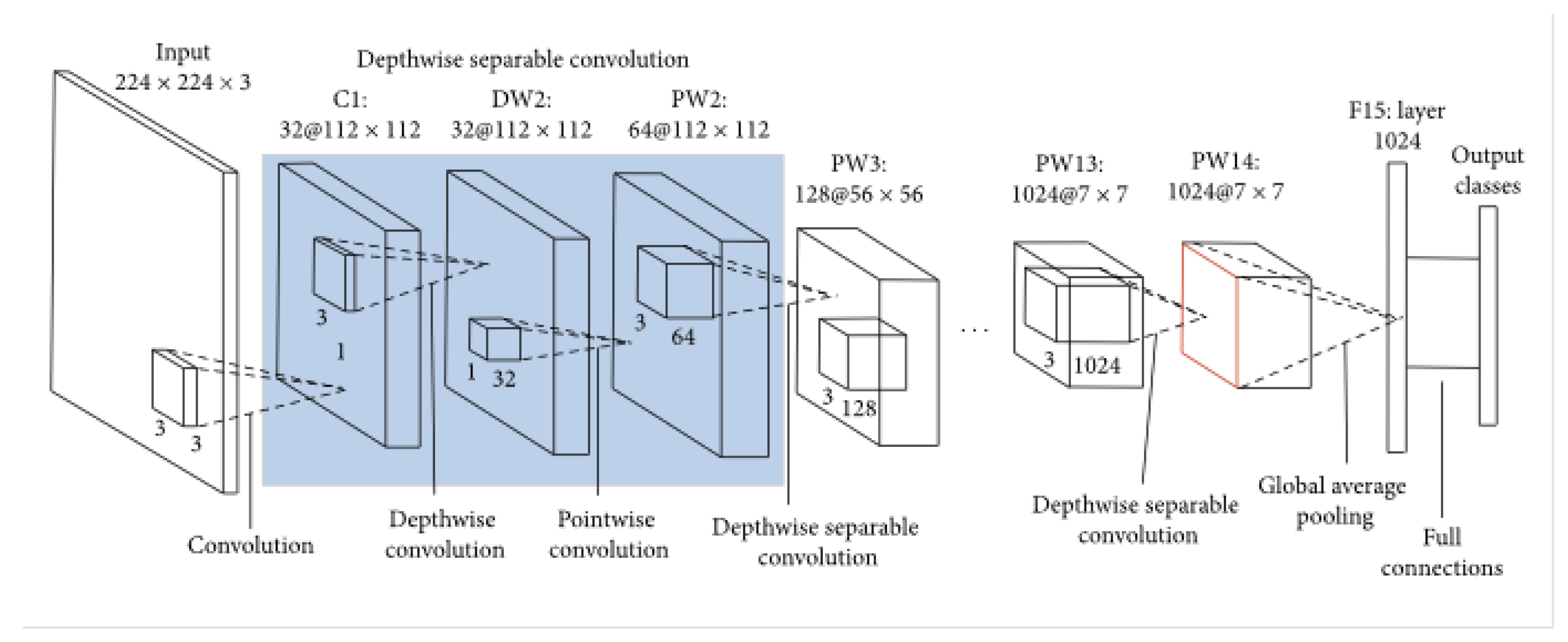
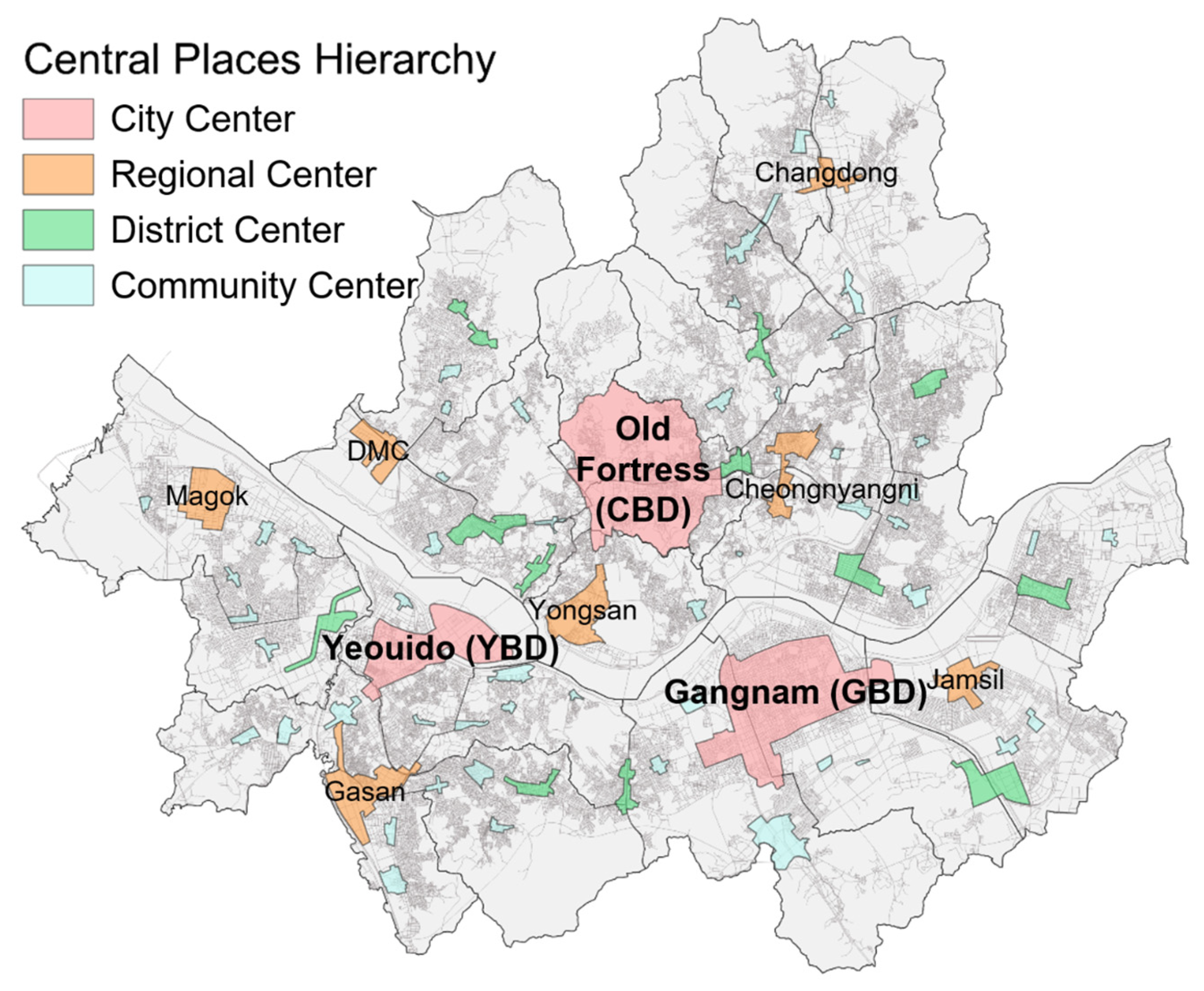
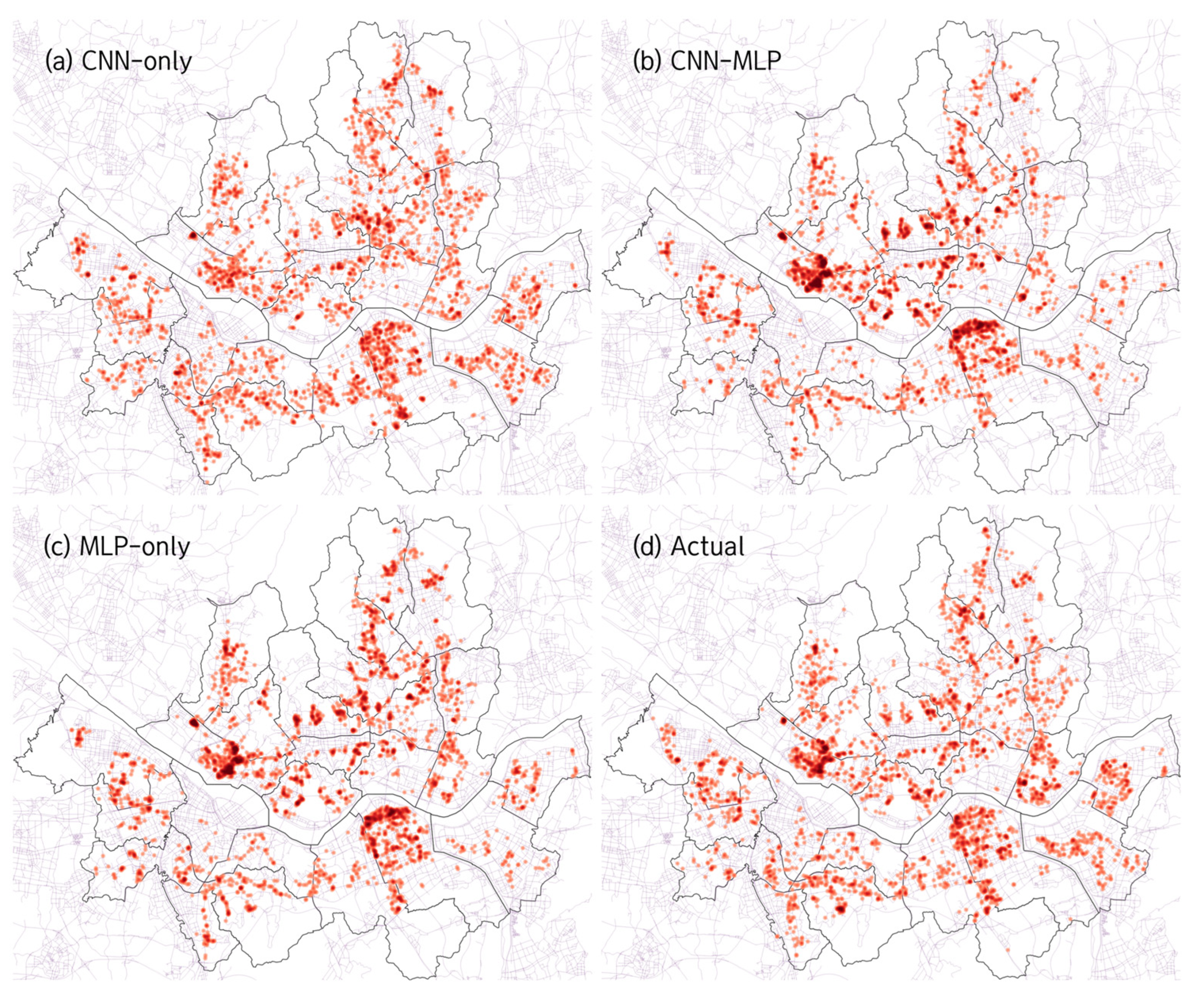
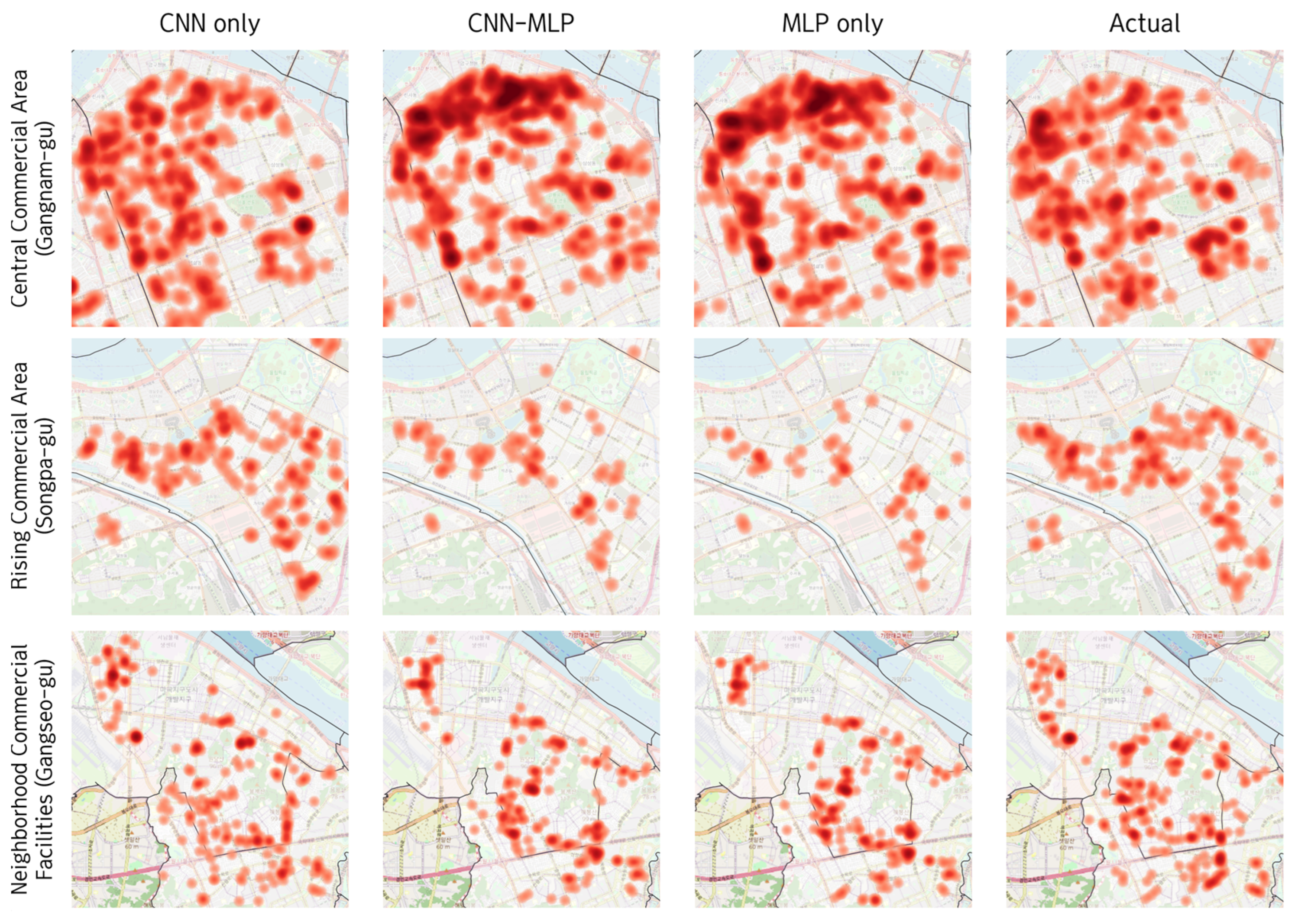
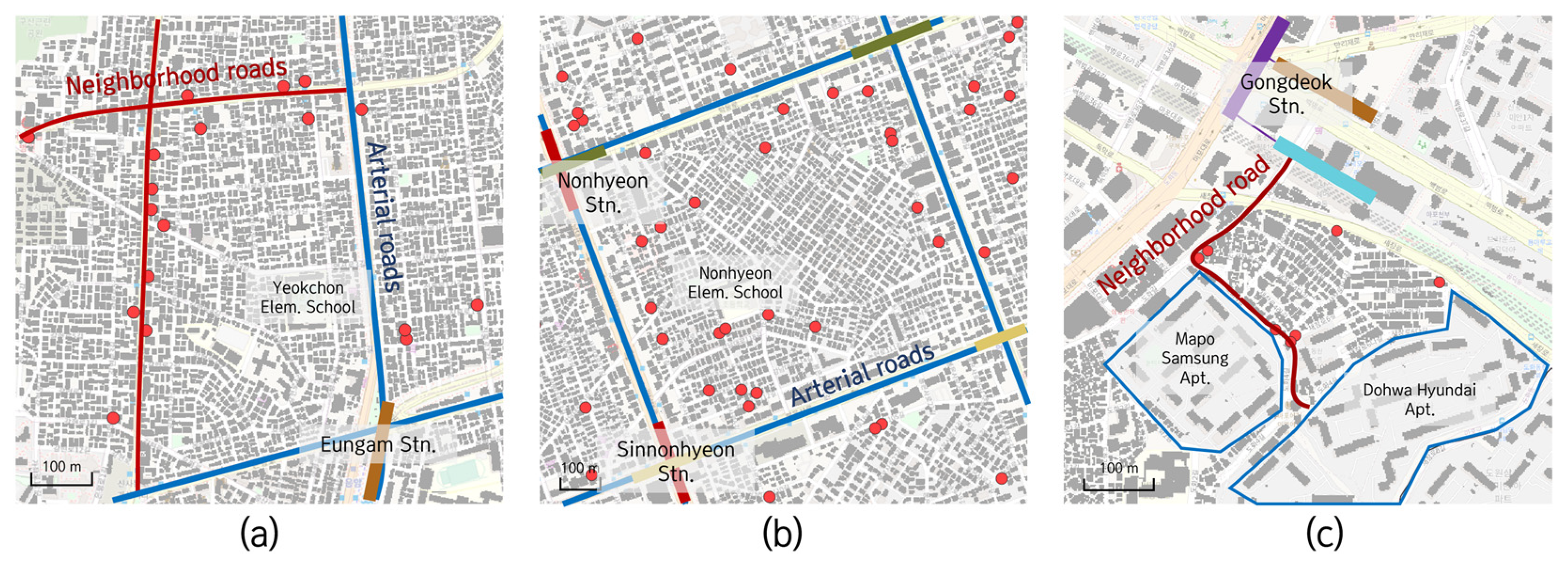
| Variable Category | Variable | Data Source | Mean | Standard Deviation | Minimum | Maximum | |
|---|---|---|---|---|---|---|---|
| Building outline image | Building outline | NSDI * integrated building data | - | - | - | - | |
| Urban form attributes | Building height | NSDI integrated building data | 11.7 | 5.2 | 0.6 | 199.6 | |
| Parcel size | NSDI land characteristics data | 650.0 | 2222.0 | 1.4 | 259,730.0 | ||
| Slope **** | NSDI land characteristics data | - | - | - | - | ||
| Regional characteristics | Zoning code **** | NSDI land characteristics data | - | - | - | - | |
| Distance to business districts | Calculated in QGIS 3.24 | CBD | 8972 | 3547 | 622 | 20,464 | |
| GBD | 10,604 | 4629 | 179 | 22,986 | |||
| YBD | 10,408 | 4946 | 422 | 26,250 | |||
| Socioeconomic characteristics | Distance to nearest subway station | Euclidean distance calculated in QGIS 3.24 | 572 | 359 | 2 | 3366 | |
| Building age | NSDI integrated building data | 23.7 | 10.7 | 0 | 80.0 | ||
| Land price | MOLIT ** officially assessed land price | 4.89 | 2.97 | 0.05 | 45.59 | ||
| Dependent Variable | Whether a restaurant is located or not **** | MOIS *** municipality business approval data | - | - | - | - | |
| Model Name | Model Input | Purpose of the Model |
|---|---|---|
| CNN-only model (Model 1) | Building form image | To evaluate the performance of CNN in predicting restaurant location |
| CNN-MLP model (Model 2) | Building form image + Attribute data | To improve the performance of CNN-based classifier |
| MLP-only model (Model 3) | Attribute data | To compare with the CNN-MLP model to assess the effect of combining CNN |
| Logistic model (Model 4) | Attribute data | To compare the machine learning models with logistic regression model |
| CNN (MobileNet-64) | MLP | ||||
|---|---|---|---|---|---|
| Type | Stride | Input Size | Type | No. of Cells | Input Size |
| Conv. + DW Conv. | 1 | 64 × 64 × 2 | Hidden layer | 200 | 1 × 1 × 15 |
| Conv. + DW Conv. | 2 | 64 × 64 × 32 | Hidden layer | 200 | 1 × 1 × 200 |
| Conv. + DW Conv. | 1 | 32 × 32 × 64 | Output (2) | 1 × 1 × 200 | |
| Conv. + DW Conv. | 2 | 32 × 32 × 128 | Classifier | ||
| Conv. + DW Conv. | 1 | 16 × 16 × 128 | Type | No. of cells | Input size |
| Conv. + DW Conv. | 2 | 16 × 16 × 256 | FC | 2 | 1 × 1 × 1024 (1) (Model 1) 1 × 1 × 1224 (1) + (2) (Model 2) 1 × 1 × 200 (2) (Model 3) |
| Conv. + DW Conv. | 1 | 8 × 8 × 256 | |||
| 4 × (Conv. + DW) | 1 | 8 × 8 × 512 | |||
| Conv. + DW Conv. | 2 | 8 × 8 × 512 | |||
| Conv. + DW Conv. | 1 | 4 × 4 × 512 | |||
| Conv. + DW Conv. | 1 | 4 × 4 × 1024 | Softmax | 2 | 1 × 1 × 2 |
| Conv. | 1 | 4 × 4 × 1024 | Output | 2 * | |
| AvgPool | 4 | 4 × 4 × 1024 | |||
| Output (1) | 1 × 1 × 1024 | ||||
| Model Parameter | Configuration |
|---|---|
| Model architecture | CNN (MobileNet-64) |
| Size of input image | (2, 64, 64) |
| Kernel size | 3 |
| Padding | 1 |
| Number of convolutional layers | 14 |
| Number of cells in flattened layer | 1024 |
| Number of metadata combined | 9 |
| Layers in metadata layers | (9, 200, 200) |
| Weight Initializer Function | Kaiming |
| Batch size | 256 |
| Learning Rate | 2 × 10−4 |
| Loss function | Cross Entropy Loss |
| Optimizer | Adam |
| Number of epochs | 100 |
| Class weights used | 1:14.65 |
| Data division ratio | 8:2 (Train, test) |
| Data augmentation method | Image: Mirror, Rotation (90°), Gaussian noise Metadata: Dropout (0.50) |
| Number of sets in augmented data | 4 |
| Software specification | OS: Windows 10 Home 21H2 Build 19044.2604 |
| IDE: Visual Studio Code 1.76.1 | |
| Python: 3.7.2/PyTorch: 1.13.1 | |
| CUDA Toolkit: 11.3 | |
| Logistic regression model: statsmodel 0.9.0 | |
| Hardware specification | CPU: AMD Ryzen™ 5 5600X 3.7 GHz |
| GPU: Nvidia GeForce RTX 3060 12 GB | |
| RAM: Samsung DDR4 16 GB × 2 (32 GB) | |
| HDD: Samsung 850 PRO 256 GB |
| Features | Details | Remarks |
|---|---|---|
| Administrative district | Seoul Special City | |
| Total area | 605.6 km2 | November 2022 (Seoul City) |
| Total population | 9,428,372 | December 2022 (KOSIS) |
| Zoning code | Residential area in Seoul City | Exclusive residential zone I, II General residential zone I, II, III Semi-residential zone |
| Residential area | 326.6 km2 | November 2022 (Seoul City) |
| Residential area ratio | 53.93% | November 2022 (Seoul City) |
| Temporal range | 16 September 2022 | Newest data from 16 September 2022 was used for the analysis |
| Metrics | Model 1 (CNN-Only) | Model 2 (CNN-MLP) | Model 3 (MLP-Only) | Model 4 (Logistic) |
|---|---|---|---|---|
| Predicted ratio of class 1 (Actual: 6.4%) | 12.56% | 16.82% | 23.91% | 28.29% |
| Accuracy | 0.853 | 0.845 | 0.818 | 0.747 |
| Precision | 0.169 | 0.230 | 0.202 | 0.167 |
| Recall | 0.333 | 0.606 | 0.757 | 0.732 |
| F-1 | 0.224 | 0.334 | 0.319 | 0.272 |
| F-1max * | 0.228 (th = 0.253) | 0.337 (th = 0.706) | 0.342 (th = 0.950) | 0.300 (th = 0.610) |
| AUC | 0.732 | 0.839 | 0.844 | 0.802 |
| Training time (epoch: 100) | 5:57:26 | 6:01:46 | 0:18:07 | 4.66 s |
| Prediction speed (it/s) | 3801 | 3807 | 58,540 | 196,314 |
Disclaimer/Publisher’s Note: The statements, opinions and data contained in all publications are solely those of the individual author(s) and contributor(s) and not of MDPI and/or the editor(s). MDPI and/or the editor(s) disclaim responsibility for any injury to people or property resulting from any ideas, methods, instructions or products referred to in the content. |
© 2023 by the authors. Licensee MDPI, Basel, Switzerland. This article is an open access article distributed under the terms and conditions of the Creative Commons Attribution (CC BY) license (https://creativecommons.org/licenses/by/4.0/).
Share and Cite
Yang, J.; Kwon, Y. Novel CNN-Based Approach for Reading Urban Form Data in 2D Images: An Application for Predicting Restaurant Location in Seoul, Korea. ISPRS Int. J. Geo-Inf. 2023, 12, 373. https://doi.org/10.3390/ijgi12090373
Yang J, Kwon Y. Novel CNN-Based Approach for Reading Urban Form Data in 2D Images: An Application for Predicting Restaurant Location in Seoul, Korea. ISPRS International Journal of Geo-Information. 2023; 12(9):373. https://doi.org/10.3390/ijgi12090373
Chicago/Turabian StyleYang, Jeyun, and Youngsang Kwon. 2023. "Novel CNN-Based Approach for Reading Urban Form Data in 2D Images: An Application for Predicting Restaurant Location in Seoul, Korea" ISPRS International Journal of Geo-Information 12, no. 9: 373. https://doi.org/10.3390/ijgi12090373
APA StyleYang, J., & Kwon, Y. (2023). Novel CNN-Based Approach for Reading Urban Form Data in 2D Images: An Application for Predicting Restaurant Location in Seoul, Korea. ISPRS International Journal of Geo-Information, 12(9), 373. https://doi.org/10.3390/ijgi12090373






